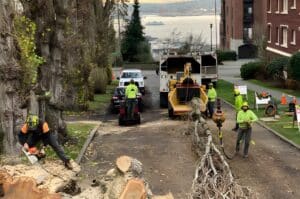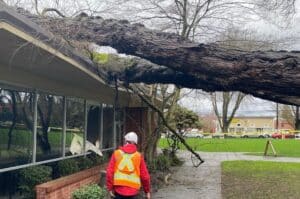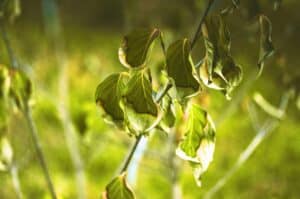Have a Leaning Tree? Prevention & Solutions for Seattle Trees
Worried about a leaning tree? Discover expert tips on maintaining stable, healthy trees in our unique climate without potential risks to your Seattle property.
Leaning trees are a common sight in Seattle, especially after heavy rains or storms. While they may concern property owners, not every leaning tree poses an immediate risk.
However, it’s important to take proper precautions to protect both your home and your trees. Let’s explore why trees develop leans, when a leaning tree is a problem, how to address it, and ways to prevent this issue.
Key Takeaways:
- Not all leaning trees are dangerous; many develop a natural tilt over time without causing issues.
- Sudden leans in larger trees are more concerning and require prompt professional attention.
- Seattle’s rainy climate, soggy soils, and windstorms significantly affect tree stability, making proper care very important.
- Choosing the right trees and planting them correctly can prevent many leaning problems in the future.
- Protecting root systems is the most important thing you can do to prevent leaning tree problems.
Identifying Dangerous Leaning Trees
Many trees naturally develop a slight lean over time, which is often not a cause for concern. If the lean has occurred gradually and the angle isn’t severe, the tree has likely adapted to its environment. This sometimes happens when a tree grows in a shaded area, reaching towards an opening to access sunlight.
In most cases, you don’t need to worry about these slow-developing leans unless the tree is near a building, driveway, or other high-traffic areas where it could cause damage if it falls.
However, if the angle of the lean is significant, the tree may be more prone to failure. An inspection by a local, Certified Arborist can provide a professional assessment of your tree’s condition, giving you much needed peace of mind.
The biggest concern is when a medium to large tree develops a sudden lean. When a previously straight tree starts leaning abruptly, often due to a storm or other factors, it presents a serious hazard. Sudden leans indicate that the tree is at risk of falling, and addressing the problem quickly is essential to prevent potential accidents or damage.
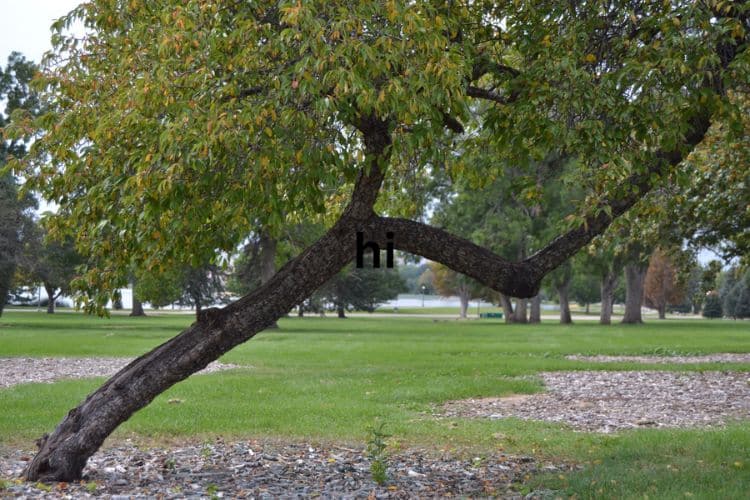
A small tree that has developed a severe, yet natural lean over time.
Common Causes of Leaning Trees in Seattle
More often than not, problems with a tree’s root system are to blame for the leaning. Tree roots stabilize trees and hold them in place.
To do this effectively, root systems often extend beyond the tree’s canopy and deep into the soil. However, when a tree can’t spread its roots sufficiently, or if the soil quality is poor or consistently wet, problems may arise. Here are some reasons a tree might suddenly start leaning:
- Soil Erosion and Saturation: Seattle’s frequent rainfall can oversaturate the soil in low-lying areas, making it soft and unstable. When trees are exposed to standing water, the soil can lose its structure, making it difficult for tree roots to hold the tree upright.
- Root Decay: Decaying or rotting roots are a common issue. This typically occurs when trees that prefer drier conditions are subjected to standing water or excessive irrigation. Rotting roots lose their ability to grip the soil and hold trees in place.
- Wind Damage: The Seattle area often experiences windstorms, particularly in fall and winter. Strong gusts can push trees to one side, especially if the tree is tall, top-heavy, or exposed to high winds without protection from nearby structures or other trees.
- Improper Planting Techniques: Sometimes trees are planted without enough space for their roots to grow deep and wide. Shallow-rooted trees, and those planted in small areas surrounded by roads, driveways, and structures, are more prone to leaning, especially in less-than-ideal soil conditions.
- Poor Pruning: Pruning should be done by Certified Arborists. Incorrect pruning can lead to imbalances, which could cause trees to lean.
Often, when a tree develops a sudden lean, it’s caused by a combination of these and other factors. For example, when soils are saturated and soft, and a strong windstorm blows through, it creates ideal conditions for pushing trees, exposing their roots, and causing them to lean.
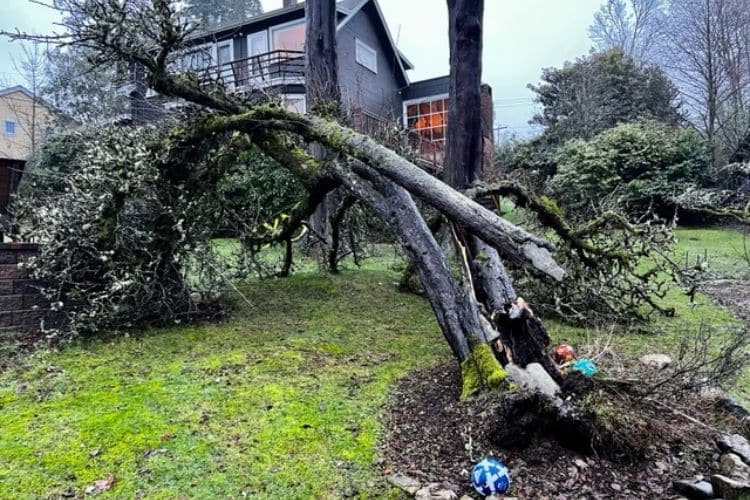
Risks of Ignoring a Leaning Tree
If you have a leaning tree on your property, it’s best not to ignore it. While they might be visually appealing, leaning trees pose several potential risks, including:
- Property Damage: Trees falling on homes, vehicles, fences, or other structures can cause a significant amount of damage.
- Power Line Hazards: Trees can potentially disrupt electricity and cause fires if it makes contact with power lines.
- Tree Health Decline: Weakened or decaying roots can lead to pest infestations and fungal diseases, further harming the tree.
- Soil Erosion: Unstable root systems can contribute to landscape degradation.
- Neighboring Property Risk: Is your leaning tree a threat to your neighbor’s property?
Preventing Trees from Leaning
Preventing a tree from leaning is much more effective than trying to correct a lean later on. The best prevention starts with proper planting. Here are some tips to reduce the chance of dangerous leaning trees in the future:
Plant the Right Trees
When adding new trees, choose species well-suited to Seattle’s climate and soil. This can be native or Seattle-friendly non-natives that thrive in the mild, wet climate of the Pacific Northwest. Select trees with deep, strong root systems that are more likely to stay upright even in challenging conditions.
Right Tree, Right Place
Choose the right tree for your yard’s conditions and plant it in the appropriate spot. Consider sunlight, soil type, and moisture. Planting in the wrong location can lead to various tree problems, including tree stress, decay, and a higher risk of leaning and structural failure. Consider soil improvements and regular fertilization to encourage robust root growth.
Staking and Guying Young Trees
For younger trees, proper staking or guying can provide the support needed to grow straight during its first year while it develops its root system. However, be sure not to leave stakes in for too long, as this can hinder natural root development, preventing the tree from building its own strength.
Regular Maintenance
Keeping a tree’s canopy balanced through regular pruning helps prevent excessive weight on one side. This not only keeps the tree growing evenly but also reduces wind resistance, lowering the risk of storm damage.
Keep Roots Healthy
A strong, healthy root system is your tree’s best defense against leaning. By focusing on root health, you can significantly reduce the risk of tree instability, ensuring your tree thrives for many decades. Some of the most important aspects of root care include:
- Water Properly: Provide deep, infrequent watering to encourage roots to grow downward. This is especially important for young trees and during dry spells.
- Address Drainage Issues: Ensure your soil drains well. Poor drainage can lead to root rot and soil instability. Consider installing drainage solutions if water tends to pool around your trees.
- Avoid Soil Compaction: Limit foot traffic and heavy equipment around your trees. Compacted soil restricts root growth and reduces oxygen availability, weakening the tree’s foundation.
- Add Mulch: Apply a 2–4-inch layer of organic mulch around the tree’s base, keeping it away from the trunk. Mulch retains moisture, regulates soil temperature, and adds nutrients as it decomposes. This also helps to minimize root damage from lawnmowers.
- Protect Roots from Damage: Be cautious when digging or landscaping near trees. Establish a protected root zone, especially during construction projects, to prevent accidental root damage.
Correcting a Leaning Tree
If one of your trees has developed a sudden lean, the most important step is to have a Certified Arborist inspect the tree. Our arborists at Seattle Tree Care are committed to saving trees whenever possible. If there’s a solution, we’ll find it.
Some of the solutions available for leaning trees include:
- Re-Staking and Anchoring: For trees that are still relatively young or have just started to lean, re-staking or anchoring the tree can help straighten it out. This method works best if the lean is caused by temporary factors like recent storms or soft soil.
- Tree Bracing and Cabling: For larger, older trees with a significant lean, professionally installed props or guy wire might be necessary. Propping involves installing supports under the tree to support the tree from below and prevent further tipping. Guying is best used to keep more mature trees from falling over, but it can be used to hold up a leaning tree. In this instance, a very strong anchor is necessary.
If the tree is leaning naturally, there’s likely nothing you can or should do for the tree. Likewise, if a tree is leaning and there’s nothing in its path that it can damage if it should fall, then you can choose to leave the tree as is.
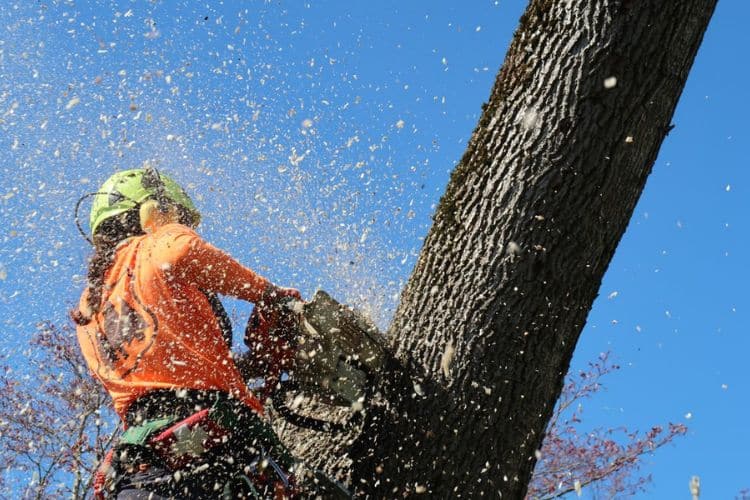
When Removal is Necessary
While many leaning trees can be saved or left alone, certain situations require removal to keep your family and property safe. Consider tree removal if you notice a tree with any of the following signs:
- Severe lean (more than 15 degrees from vertical)
- Exposed or severely damaged roots
- Significant decay or disease
- Leaning over structures, power lines, driveways, or roads
- Recent, sudden lean after storms
- Cracked or heaving soil at the tree’s base
- Dead or dying tree with a noticeable lean
- Located in a high-traffic area
- Blocking essential views or walkways
If you think your leaning tree should be removed, call us today at 206-789-0534. We’re happy to inspect the tree to see if removal is necessary. If so, we’ll provide you with a prompt, free quote. Otherwise, we’ll offer recommendations for saving the tree.
Protect Your Seattle Trees Today
Preventing leaning trees starts with you. By choosing the right trees, planting them correctly, and taking proper care of them and their roots, you can help keep your trees healthy, straight, and structurally sound.
Seattle Tree Care is ready to help you every step of the way. Call us at 206-789-0534 for help with your leaning tree, or for a free tree removal quote today.
SEE MORE ARTICLES FROM OUR b(LOG)
We've got you covered with tips, resources, updates, how-to's, and other helpful information about trees and landscapes in Seattle, Puget Sound, and King County, WA. Join the thousands of smart local residents who get the monthly newsletter from Seattle Tree Care for helpful information you won't want to miss!
There's no spam - we promise! We are committed to keeping your e-mail address confidential. We do not sell, rent, or lease our contact data or lists to third parties.

